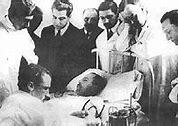In this 21st book in the "William Monk" series, set in the mid-18oos, an unscrupulous doctor is using extremely unethical procedures. This leads to a trial that raises interesting issues about medical research. The book can be read as a standalone.
*****
Hester Monk honed her considerable nursing skills during the bloody Crimean War, where she worked alongside legendary Florence Nightingale. Years later Hester is married to Commander William Monk of the Thames River Police and running a women's clinic/shelter in London.

As the book opens Hester is temporarily substituting for a friend at the London Royal Naval Hospital when she comes across three young siblings (Mike, Charlie, and Maggie - ranging in age from 4 to 7) living in the hospital annex. Charlie is on the brink of death and Hester nurses him back to health. She then promises to check in on the youngsters periodically. Hester doesn't seem to question what the kids are doing there, presumably because nurses at the time garnered little respect; they were supposed to shut their mouths and do their jobs.

The basic plot of the story revolves around two hospital honchos, Magnus Rand - a physician, and his brother Hamilton Rand - a chemist. The Rands, seeking a cure for the deadly "white blood disease" (leukemia), are treating patients with blood transfusions. However, this is the mid-1800s and medical science is unaware of different blood types, etc. Thus, the transfusions are more likely to kill the patients than cure them.
As the story proceeds, middle-aged wealthy arrogant Bryson Radnor, suffering from white blood disease, becomes a patient at the hospital. The Rand brothers ask Hester to nurse Radnor while they administer their blood transfusion treatment - which seems to help him.

It turns out the Rands are using the blood of the annex children which - for reasons the brothers don't understand - can be successfully transfused into anyone. (Note: It would now be known the children are universal donors with type O blood).
When Hester realizes the children are being systematically bled she raises a ruckus. Immediately afterward Heather is abducted and finds herself and the children imprisoned in a remote house where Hamilton Rand, determined to perfect the transfusion procedure, is treating Radnor. Hester, being a dedicated nurse, feels compelled to assist despite the circumstances. Hester knows, however, that Hamilton Rand - who is committing some big crimes - will eventually kill her and the children to avoid exposure.
Meanwhile, Commander Monk (Hester's husband) and his team are desperately trying to find Hester. Along the way they learn that the kids - Mike, Charlie, and Maggie - were sold to the Rands by their destitute parents, who thought they were going to a good home.
Eventually all this leads to a trial where Hamilton Rand is the defendant. Attorney Oliver Rathbone, who once proposed marriage to Hester, helps prosecute. The trial raises some interesting issues, including the need for experimentation to advance medical science. There are plenty of ethical considerations here, including buying children and using human subjects without appropriate disclosure and consent.

The book has an interesting premise but moves too slowly and gets boring in places. On the plus side it has some interesting - though despicable - characters. Hamilton Rand and Bryan Radnor are self-centered, misogynists who treat women (including Hester, whose help they desperately need) as being beneath them and not deserving of respect. This kind of thing is a trademark of Anne Perry's mysteries, where class and socio-economic distinctions are always prominent. I assume this is a realistic depiction of the times but it always irritates me.
All in all, this is a moderately compelling book, with some favorite characters that recur in the series. The story's not too deep or complicated, so it's an easy read.
Rating: 3 stars

No comments:
Post a Comment